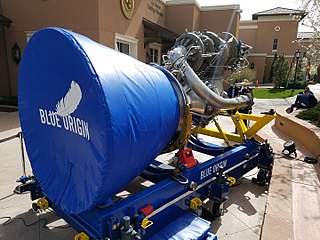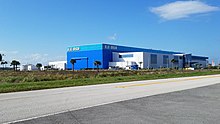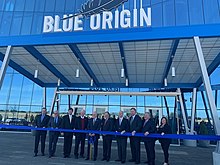
Cape Canaveral Space Force Station (CCSFS) is an installation of the United States Space Force's Space Launch Delta 45, located on Cape Canaveral in Brevard County, Florida.

Blue Origin, LLC is an American privately funded aerospace manufacturer and sub-orbital spaceflight services company headquartered in Kent, Washington. Founded in 2000 by Jeff Bezos, the founder and executive chairman of Amazon, the company is led by CEO Bob Smith and aims to make access to space cheaper and more reliable through reusable launch vehicles. Rob Meyerson led Blue Origin from 2003 to 2017 and served as its first president. Blue Origin is employing an incremental approach from suborbital to orbital flight, with each developmental step building on its prior work. The company's name refers to the blue planet, Earth, as the point of origin.

Launch Complex 39A (LC-39A) is the first of Launch Complex 39's three launch pads, located at NASA's Kennedy Space Center in Merritt Island, Florida. The pad, along with Launch Complex 39B, were first designed for the Saturn V launch vehicle. Typically used to launch NASA's crewed spaceflight missions since the late 1960s, the pad was leased by SpaceX and has been modified to support their launch vehicles.

Launch Complex 39 (LC-39) is a rocket launch site at the John F. Kennedy Space Center on Merritt Island in Florida, United States. The site and its collection of facilities were originally built as the Apollo program's "Moonport" and later modified for the Space Shuttle program.

Launch Complex 36 (LC-36)—formerly known as Space Launch Complex 36 (SLC-36) from 1997 to 2010—is a launch complex at Cape Canaveral Space Force Station in Brevard County, Florida. It was used for Atlas launches by NASA and the U.S. Air Force from 1962 until 2005.

New Shepard is a fully reusable suborbital launch vehicle developed by Blue Origin for space tourism. The vehicle is named after Alan Shepard, the first American astronaut in space. The vehicle is capable of vertical takeoff and vertical landing, and can carry a crew.

Corn Ranch, or Launch Site One, is a spaceport in the West Texas town of Van Horn, Texas. The 670-square-kilometer (165,000-acre) land parcel was purchased by Internet billionaire Jeff Bezos. Current launch license and experimental permits from the US government Federal Aviation Administration authorize flights of New Shepard rockets. The first flight test took place on November 13, 2006 with the goal of providing commercial tourist flights. Blue Origin’s first human spaceflight launched at Corn Ranch on July 20, 2021. The flight, dubbed NS-16, carried founder Jeff Bezos, his brother Mark Bezos, test pilot and Mercury 13 member Wally Funk, and Dutchman Oliver Daemen on a suborbital flight aboard New Shepard 4.

Vertical takeoff, vertical landing (VTVL) is a form of takeoff and landing for rockets. Multiple VTVL craft have flown. The most widely known and commercially successful VTVL rocket is SpaceX's Falcon 9 first stage.

Launch Complex 11 (LC-11) at Cape Canaveral Space Force Station, Florida, is a launch complex used by Atlas missiles between 1958 and 1964. It is the southernmost of the launch pads known as Missile Row. When it was built, it, along with complexes 12, 13 and 14, featured a more robust design than many contemporary pads, due to the greater power of the Atlas compared to other rockets of the time. It was larger, and featured a concrete launch pedestal that was 6 metres (20 ft) tall and a reinforced blockhouse. The rockets were delivered to the launch pad by a ramp on the southwest side of the launch pedestal.

Launch Complex 18 (LC-18) is a launch complex at the Cape Canaveral Space Force Station, Florida that was active during the late 1950s and early 1960s. It was used by Viking, Vanguard, Thor and Scout rockets. The complex consists of two launch pads, LC-18A, which was originally built by the US Navy for the Vanguard rocket, and LC-18B, which was originally by the US Air Force used for tests of the PGM-17 Thor missile.

Astra is an American launch vehicle company based in Alameda, California. Astra was incorporated in October 2016 by Chris Kemp and Adam London. Formerly known in media as "Stealth Space Company", the company formally came out as Astra Space, Inc. in a Bloomberg L.P. article by Ashlee Vance. Investors include BlackRock, Advance, ACME, Airbus Ventures, Innovation Endeavors, Salesforce co-founder Marc Benioff, former Disney CEO Michael Eisner, and more.

The BE-3 is a LH2/LOX rocket engine developed by Blue Origin.

As of 2020, SpaceX operates four launch facilities: Cape Canaveral Space Launch Complex 40 (SLC-40), Vandenberg Space Force Base Space Launch Complex 4E (SLC-4E), Kennedy Space Center Launch Complex 39A (LC-39A), and Brownsville South Texas Launch Site. Space Launch Complex 40 was damaged in the AMOS-6 accident in September 2016 and repair work was completed by December 2017. SpaceX believes that they can optimize their launch operations, and reduce launch costs, by dividing their launch missions amongst these four launch facilities: LC-39A for NASA launches, SLC-40 for United States Space Force national security launches, SLC-4E for polar launches, and South Texas Launch Site for commercial launches.

The Blue Engine 4 or BE-4 is an oxygen-rich liquefied-methane-fueled staged-combustion rocket engine under development by Blue Origin. The BE-4 is being developed with private and public funding. The engine has been designed to produce 2.4 meganewtons (550,000 lbf) of thrust at sea level.
New Glenn is a heavy-lift orbital launch vehicle in development by Blue Origin. Named after NASA astronaut John Glenn, design work on the vehicle began in 2012. Illustrations of the vehicle, and the high-level specifications, were initially publicly unveiled in September 2016. New Glenn is a two-stage rocket with a diameter of 7 m (23 ft). Its first stage will be powered by seven BE-4 engines that are also being designed and manufactured by Blue Origin.

The billionaire space race is the rivalry among entrepreneurs who have entered the space industry from other industries - particularly computing. This private industry space race of the 21st century involves sending rockets to the ionosphere, orbital launch rockets, and suborbital tourist spaceflights.
Jacklyn — formerly known as the Blue Origin landing platform ship or, officially in 2018–2021, as LPV; and before that, Stena Freighter, Stena Seafreighter, RFA Sea Chieftain, and Stena Hispanica — was being refit in 2018–2022 from a former roll-on/roll-off cargo ship for possible use as a landing platform ship. The ship was then owned by rocket and space technology company Blue Origin, and was purchased in 2018 for use as a floating landing platform for Blue Origin's New Glenn launch vehicle booster stage. During 2018 to 2022, the ship had been in port undergoing refit to prepare for a novel role of landing launch vehicle first stages. Ultimately, Blue Origin abandoned their plans to use the ship as a landing platform, and in August 2022, the ship was towed to the Port of Brownsville for scrapping.
A floating launch vehicle operations platform is a marine vessel used for launch or landing operations of an orbital launch vehicle by a launch service provider: putting satellites into orbit around Earth or another celestial body, or recovering first-stage boosters from orbital-class flights by making a propulsive landing on the platform.
















